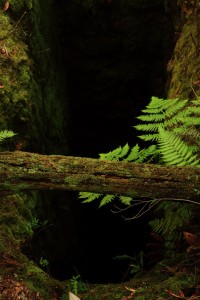The abyss, the black space, the human-sized hole in the ground, the void. There is a visceral reaction: the body senses danger. More than senses, it reads the consequences, knows the fate of a fall. The language of terror, that fundamental instinct, the signifiers of fear are inside and outside of rationality. This is the body denying its futility; it can see itself as an image of precariousness, alteriority, uselessness in the face of physical experience, yet the signifieds are readable as a displaced image, rather than an unfettered actuality (is there such a space?). The body still needs to make reason through language with recognizable signifieds. What is the bodily relation to this hole in the ground? How does the body figure proximity, depth, mass, darkness? The picture, the image-repertoire is more secure than the realm of the infinite and unknown signified.
I can see my fear, I can see my body peering into the hole, on the edge of the abyss. I can imagine that moment of loosing balance, toppling. That moment of loosing balance is when the image is taken, where fear is transformed—but not represented, for how can fear be represented?—into a visual text, the photograph. My bodily reading of this experience is now reconstructed as a flat image; how can this experience have anything to do with this image? The image now exists for itself, it has been set free from personal indentification, the signifiers are free to do their own work. The relation is now with the body of the reader, my body has moved on.
Yield, 2011

